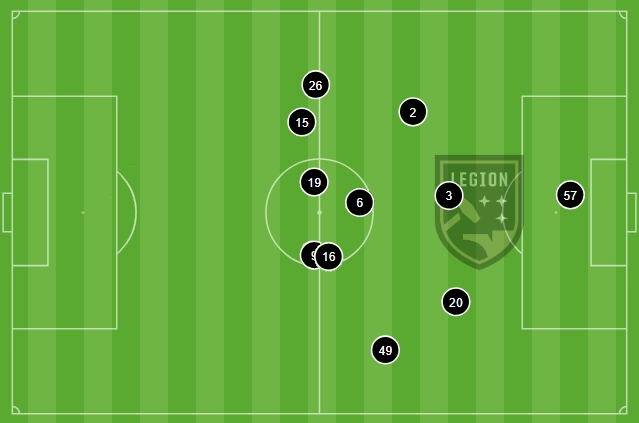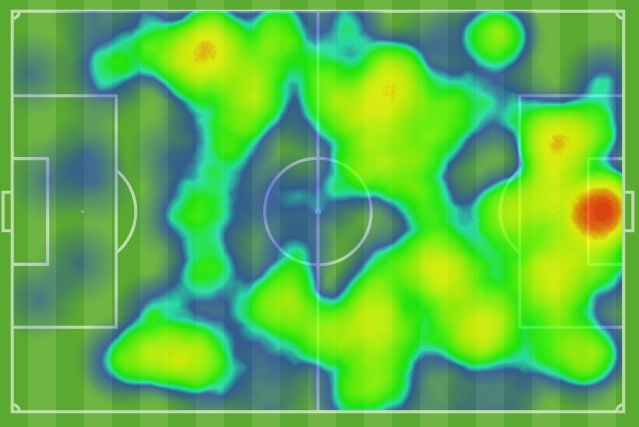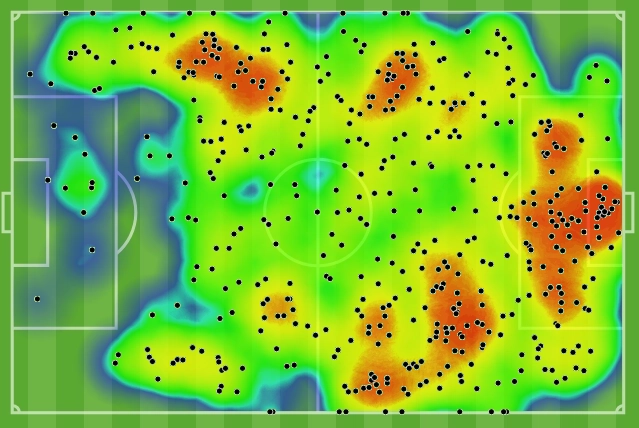It’s perhaps not unusual that when a team plays two games separated by just a few days those two games end up being very different. That would be because the tight scheduling generally demands some rotation in the lineup in order to allow for rest.
This game did progress very differently than the midweek tilt with North Carolina FC, but the lineup against Loudoun United remained almost the same. Only one starter was changed: Jackson Travis at left wingback instead of Dawson McCartney. Both games were played out of a 5-3-2, although the front 5 may have moved around a bit.
The decision to do that may well have been influenced by the fact that the Legion has a bye this week. The bye is incredibly fortunate scheduling, by the way. Phanuel Kavita, A.J. Paterson and Ramiz Hamouda have all been called up for this week’s international break, which would leave the Legion with extremely limited defensive options. Additionally, the Three Sparks’ next opponent, co-eliminee The™ Miami FC, plays away at Louisville City Saturday before making the trip here. All of that probably led Mark Briggs to keep his starting XI pretty much unchanged.
But everything else did. Here’s a quick snapshot of some key statistics from the two games:
| Legion | Loudoun United | Legion | North Carolina | ||
|---|---|---|---|---|---|
| Possession | 34.6% | 65.4% | 56.8% | 43.2% | |
| Shots | 6 | 19 | 13 | 6 | |
| Shots on target | 2 | 7 | 3 | 2 | |
| Passing accuracy | 70.0% | 83.2% | 87.7% | 84.8% | |
| Crosses | 2 | 26 | 22 | 3 | |
| Touches in the attacking 18 | 10 | 39 | 25 | 3 | |
| Clearances | 43 | 15 | 4 | 32 |
As you can see, the two games are nearly mirror images. Other data also bear this out. As you read this you may want to open our analysis of the North Carolina game in a separate tab or window for comparison; that post can be found here. To start, let’s take a look at the average positions for the starting XI (playing right to left):

That alone shows you that the Three Sparks were unable to find much penetration. If anything, the player who found the most success moving forward was right back Amir Daley (#26), who is right up there with the front 3. No surprise, then, that the heatmap for the first half was very similar to Wednesday night’s first half. Against North Carolina in the second half the Legion were in the attacking end virtually the entire time. Not so Saturday:

What is interesting here is that the Legion was out wide much of the time, whether by being pushed out of the center or by design. But look at the number of crosses: just 2 all game versus a whopping 26 for Loudoun. The Legion did not win a single corner all game; Loudoun had 12. And of those 2 crosses one was a free kick (from a good distance back).
This is the heatmap for the full game, with the touchmap overlaid:

The 10 touches in the Loudoun box include A.J.’s penalty kick, which really doesn’t count. The 9 open play touches were contributed by 6 different players; of those only Enzo Martinez (3) and Peter-Lee Vassell (2) had more than 2. Tyler Pasher’s only touch resulted in the penalty though, so that was well worth it.
As for the touches in the Legion’s own 18, only 4 of the 16 players in the game did not provide any: Tyler Pasher, Preston Tabort Etaka, Erik Centeno and Jake Rufe. Erik only played about a minute when Loudoun was briefly down to 10 men, so that’s hardly a shocker. Even Ronaldo Damus had 4 touches, and 2 of those were inside the 6-yard box, not just the 18. Which is to say, this was a full-team defensive effort. Field players accounted for 52 touches in the box; Fernando Delgado had so many they can’t be counted from the available data because they overlap so much, but they add up to well over 30.
Another striking difference in the 2 games was the clearance numbers. We did not address this much in the North Carolina post, so take a look at the side-by-side comparison:

This is a bit confusing; the Loudoun game is on the left with the Legion in black. The North Carolina game on the right has the Legion in brown. From the way it looks you would think the same team is black in both games. Other than the roles flipping the only true difference here is that Loudoun had to work a bit harder to keep the Legion out than the Legion did to keep North Carolina out. It also shows in part how Loudoun kept the Three Sparks out of the final third.
All in, this was a classic bend-but-don’t-break performance. Loudoun ended the game with a 1.51 xG but were unable to convert that. You may heard the Legion xG discussed during the broadcast. That was 1.21 at the final whistle, of which well over 0.9 was from the penalty kick. You convert one good chance; sometimes that’s all you need.
That the Legion had fewer total shots than Loudoun had on target is remarkable (and also coincidentally the exact same numbers as North Carolina). Fernando had an excellent evening between the sticks, racking up 6 saves (the other shot on target was stopped by Stephen Turnbull). He sat behind an impenetrable defensive wall. The 6 players in his line (the 5 starters plus Jake Rufe) recorded an aggregate 8 tackles, 33 clearances and 3 interceptions, all while winning 26 of 38 duels, a massive 68.4%.
Which only leads to the question: which of them was Gandalf and which Loudoun attacker was the Balrog?
As a final point: there is a very good reason why these two games played out so differently. North Carolina, as we have mentioned, is a notoriously low-shooting team, albeit with a very high conversion rate. Loudoun has very nearly the same conversion rate but is both high-scoring and high-shooting, 5th in the Championship in both categories. A different approach was needed. It’s also impressive that the Legion had just one day of practice after the Wednesday game to prepare.
Sadly, this all came too late but at least this team is finally showing that it can compete.





